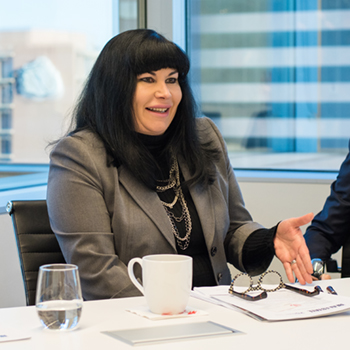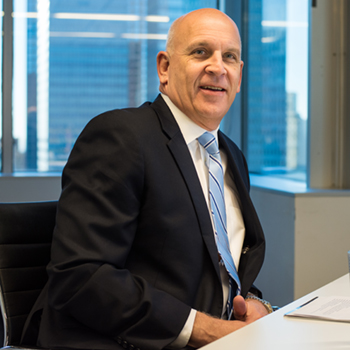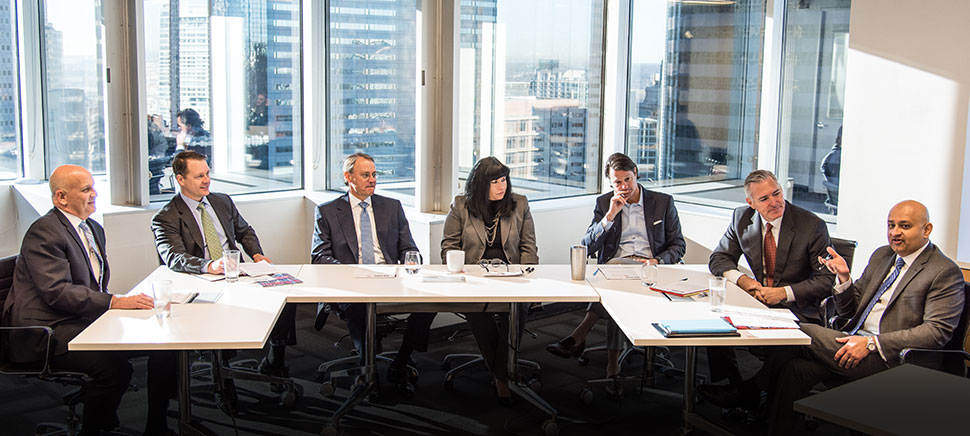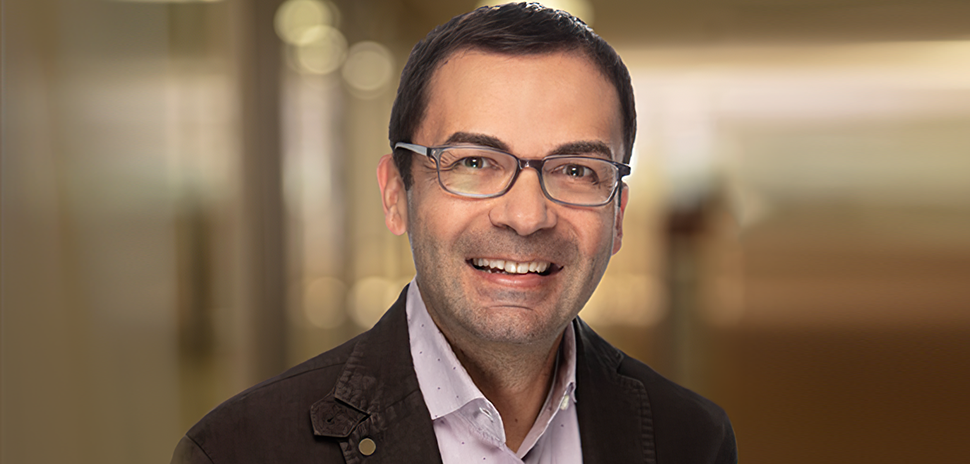This article originally appeared in the Dallas-Fort Worth Real Estate Review, Spring 2016. Part II of this series will appear on Dallas Innovates May 31.
FIRST OF A THREE-PART SERIES. READ PART II AND PART III. PANEL MODERATED BY CHRISTINE PEREZ.
THE PANELISTS (pictured above, left to right):
BRYAN MARSH As vice president, Bryan Marsh serves as Digital Realty’s Central region portfolio manager. He has overall responsibility for strategic planning, acquisitions, development, operations, leasing, and financial performance of 43 buildings with 4.7 million rentable square feet.
BRYAN LOEWEN Bryan Loewen leads Newmark Grubb Knight Frank’s global data center practice. He works closely with the company’s 300 worldwide offices to help companies develop business continuity plans and mission-critical strategies involving data centers, colocation sites, and hosting facilities.
BILL BURTON As executive vice president of Hillwood Properties and Hillwood Urban, Bill Burton has been a key player in the transformation of AllianceTexas from raw ranch land to an 18,000-acre, masterplanned development. He also was instrumental in bringing a Facebook data center to Fort Worth.
CAROLINE BRELSFORD Caroline Brelsford is central regional director for CyrusOne, which specializes in reliable enterprise data center colocation. A seasoned industry executive, she has helped the world’s leading brands reduce risks and costs associated with critical data center infrastructure.
BO BOND Bo Bond is managing director and co-leader of JLL’s global data center solutions practice team. A recognized industry leader with more than 24 years of experience, he has successfully negotiated more than 20 million square feet of real estate transactions in multiple states.
BRANT BERNET As senior vice president in CBRE’s brokerage services group, Brant Bernet leads the firm’s data center team. He previously was a principal at Trammell Crow Co., where he helped pioneer high-tech tenant representation. He went on to launch Rackhouse Group, which focused on data center site selection.
ANDY ABBAS Andy Abbas, co-founder and vice president of Data Agility Group, which specializes in data and data center migrations, data center relocations and consolidations, and related services. He has been in the industry for more than 30 years, holding IT executive posts at AT&T and Sears.
Dallas-Fort Worth has quietly become the nation’s No. 2 data center market. To get an update on activity in the region, we gathered some of the top minds in the business for a panel discussion. Here’s what they had to say:
Let’s start with a look back at 2015 and North Texas data center market activity and absorption. Did it fall short, meet, or exceed expectations?
BO BOND: JLL just released a report on what happened in major U.S. markets — a wrap-up of 2015 and highlights of 2016. Specifically to Dallas, we saw greater than 40 megawatts on the multitenant data center front absorb. That’s 250 kilowatts and up. Outside of that, you would have very large enterprise data centers that were built, which we wouldn’t put in the absorption model. If you look at Facebook, you look at State Farm delivering its data center, we wouldn’t put those into the numbers.
Absorption is the rate at which space is filled.
BRYAN MARSH: Just a point of reference for those who may read this and don’t know, the metric for data centers is kilowatts or megawatts; that’s how we measure the increments we lease. It’s all based on IT load — what can service the computers in the data centers. For Digital Realty, we did 15 megawatts of IT loads in 2015. That was up from 7 megawatts in 2014. We almost doubled it. We typically see about 10 or 11 megawatts per year of absorption in our portfolio in Dallas. So, it was a better-than-normal year. In 2015, we saw an increase over 2014 and 2013, and it was strong for Dallas, in comparison to the rest of the country. Northern Virginia, which led it, was well into the 60s. Dallas was the second-largest market in the U.S. from an absorption perspective. I think everybody in this room is pretty excited about that. And I think everybody had a hand in that. As we look forward to 2016, we’re going to find a unique situation where there’s starting to be constraints on space, something that Dallas really has never run into.
“As we look forward to 2016, we’re going to find a unique situation where there’s starting to be constraints on space, something that Dallas really has never run into.” – Bryan Marsh
BRANT BERNET: So your double was just in Dallas?
MARSH: Just in Dallas, right. When Bo was talking about 40 megawatts of absorption in Dallas, about 16 of that was from Digital Realty.
BERNET: The only thing I would add to that is, in 2015, we ran a couple of projects where really, truly, for the first time, we only had a couple of options. Thankfully, there’s a lot of potential construction going on that will bring that back into alignment.
BOND: Compare that to traditional real estate. For the person looking for a warehouse or retail or office, to have just two or three options total — that’s unheard of.
BERNET: There were a couple of “sold-out” signs in 2015.

Caroline Brelsford, photo by Michael Samples.
CAROLINE BRELSFORD: A few years ago, we started increasing our scale of the footprint of our data halls — we deliberately enlarged. We take what I’ll call a factory approach or an assembly-line modular approach to building. We structured that process through our construction arm so we could keep up with the type of demands that were coming. We could see it coming on the horizon. The scale has served us well … to have the larger data halls, to be able to scale up additional megawatts on a moment’s notice. That’s been key to supporting some of the emerging growth we’ve seen coming into the market.
ANDY ABBAS: One of the things that we’ve seen, particularly in the scale end, is more organizations creating a lot denser racks, because that would help the real estate requirements. You minimize the requirements to a certain extent and you’re going to have a lot more compute within a rack. That provides scalability to the organization so they can scale better and faster than having to span across multiple data centers and multiple racks. On the flip side of it, that obviously puts a lot of load on the power and cooling for that same rack. Historically, if it has only been 5 kilowatts and now you’re up to 8 or 9 or 10 kilowatts, that increases the load on the entire data center. What we’re seeing is more organizations are wanting to put more functionality and compute in individual servers, versus spanning across multiple — particularly with the virtualization and cloud piece of it.
CAROLINE BRELSFORD: We call that vertical growth. Because that will also have a positive impact on the client over time. As their IT infrastructure changes, they refresh their servers, the servers process more efficiently, they also reject more heat. When the data center is designed to accommodate the vertical growth, the client does not have to necessarily add more space when they need to refresh their IT kit. It also has positive benefits long term.
BRYAN LOEWEN: To the original question, if you look at it from Wall Street’s perspective and others, I think we exceeded expectations in the market. The inventory is at a low point here. We look at other markets across the U.S., and there are similar markets that had a lot of absorption. But the Dallas-Fort Worth market, when there’s very little inventory left, I think you have to look at it having exceeded expectations.
BOND: That’s a great point. You look at the public market this past year, everybody thought maybe we were in a bubble here in Dallas, a lot of cranes coming out, headquarters relocations. But if you look across the county, the stock market stayed fairly flat at the end of the year. We’ll use the term in this room, “Big Six.” There are six larger, publicly-traded real estate investment trusts on the data center side, that the market is really starting to track. They ended up 30-plus percent, if you average weight them, over the market. So, performance at the public level is extremely positive. You look at the traditional real estate category; they’re down five percent. So there are really strong metrics at the public markets level. That’s something we’ve seen over the last few years. The public markets are very instrumental to this industry, how these guys come in and build, and where they build.
“There are six larger, publicly-traded REITs on the data center side, that the market is really starting to track. They ended up 30-plus percent, if you average weight them, over the market.” – Bo Bond
BILL BURTON: With regard to the vertical growth inside the buildings: Where does it put stress on the buildings, and does it start to limit anything in this area, with respect to growth?
BERNET: I think the biggest stress is the power piece. We’ve got good, clean, and abundant power here. So my knee-jerk reaction would be, bring it on. I think it’s going to be fine. Some of the constraints of how you build, especially where you have restrictions on the equipment yard where you can’t bring in more generators, like in a downtown environment, it would be difficult to expand that. But most of what we’re seeing is big equipment yards, big setbacks, the opportunity to grow that equipment yard kind of as large as you want, and then all you’ve got to do is bring in more power.
What is driving all of the demand that we’re seeing, here in this market and nationally?
BRELSFORD: It’s the explosion of data, the amount of data that continues to compound every year. I read somewhere, to put it in perspective, that we’ll be at 44 data bytes by the year 2020. To give an idea what that means, it’s as if every human being on the planet were receiving 174 newspapers per day, just to get to 1.9 data bytes.
“A cell phone alone today, an iPhone 6, could support over 100 Apollo-type rockets. Clients today look at the data, and they want the velocity of that data.” – Caroline Brelsford
A cell phone alone today, an iPhone 6, could support over 100 Apollo-type rockets. The technology in such a small chassis can yield so much processing. Clients today look at the data, and they want the velocity of that data. Gone are the days where [clients] want to hear they have restrictions on how they access that data. We’re even seeing clients begin to re-tool their applications with Herculean efforts to do so, such that they’re not bound by a particular geography. The cloud has helped drive that in many respects. That’s why Dallas is such a good location, even for enterprises that aren’t located here today, because of the clean power, the economy, the affordable living, good access to power, et cetera. It makes Dallas a viable option because they’re re-tooling their applications that data can be accessed.

Bryan Marsh, photo by Michael Samples.
MARSH: We call it “SMACC.” And that’s not trash talk. That’s social, mobile, analytic, cloud, and content. To us, those are the big drivers in the market. Social being Facebook, LinkedIn, online gaming; mobile with smartphones, laptops, wearable devices transmitting data; analytics revolves around big data, analyzing information, recognizing patterns, and making predictions, algorithms, that sort of thing; the cloud, obviously, is where the internet resides; and then content, with streaming like Netflix and Comcast.
BURTON: That stuff doesn’t go away. And that’s part of the issue. More users, more user engagement. And the product, it’s changed. It’s gone from pictures to streaming.
ABBAS: That’s in addition to the consumer-driven data, because it’s so easy for organizations to deploy systems — you can deploy a system within minutes, versus having to wait for two weeks. What happens with that is organizations are becoming more fluid in what they’re doing. So if they need to send up a VM (virtual machine) and say, “I’m going to test at one functionality,” they don’t really have to think about it other than, “OK, these are the steps I need to take. Within 20 minutes, I’m going to be done, and up and running.” So they’re deploying more and more VMs. That, in turn, is growing the data center environment. As [organizations] grow, the back-end infrastructure needs to be able to accommodate that.
” … we’re pretty fortunate here. Because the users that took space in this market in 2015 were extremely diversified.” – Bo Bond
BOND: If you look at what happened in Dallas, we’re pretty fortunate here. Because the users that took space in this market in 2015 were extremely diversified. They mirror what happened in the larger office market. If you look at Northern California, it’s major technology companies, major social media companies. But in Dallas, we had major social media companies, a major transportation network company we’re all using to get places on our smartphones. We had huge healthcare land this year. We had nice financial institutions that landed this year. The cloud companies took a ton of space this year. Our automobile manufacturers took space here. So, there was very diversified absorption. It came from every industry vertical. That’s good for all of us.
How does Dallas stack up in terms of access to talent?
BRELSFORD: It’s absolutely phenomenal. You have major university systems here. You have good trade schools. Dallas is a place where young, career-minded people want to be. You have transportation systems for those who want to live downtown and maybe commute outward to work. It’s a very diverse and very strong human capital market in my mind. It’s unusual, because we see other markets where you may have difficulty hiring or staffing someone for a period of time until you find the right one. Here, it’s not uncommon for us to have several qualified candidates come in. We’re having to interview more times to try and figure out which one is the right fit. But I believe the quality of living here attracts individuals to work for us and, of course, just the education system here — even for ongoing, continuous education for employees is excellent.
” … I believe the quality of living here attracts individuals to work for us and, of course, just the education system here — even for ongoing, continuous education for employees is excellent.” – Caroline Brelsford
BERNET: Having said that—and you and Bryan would know better than anybody, because I completely agree with that. But the engineers are in short supply, right? It’s hard to find good engineers to run good data centers, even in Dallas, especially because there’s just so much going on. Is that right?
MARSH: Yeah. We’re having to raid our competition a little bit for good engineers.
BERNET: Seems like the good ones bounce from place to place.
BURTON: Don’t you think it’s relative? We’ve got a very large pool relative to the rest of the country. If you’re looking for talent, that’s what we understand in the companies that we’ve worked with. For Facebook most recently, talent was one of the big criteria for them. And then also access from the West Coast, having enough direct flights to and from the Valley. It’s very important getting those people here. Those were two critical components.
“We’ve got a very large [talent] pool relative to the rest of the country.” – Bill Burton
BRELSFORD: I certainly haven’t seen that challenge for our partners delivering what I’ll call higher-end solution technology engineering skill sets. Perhaps, maybe, on some of the mechanical facility side, that might be a challenge for some. One of the other things that attracts clients to this market is the fact you have large hubs for what I’ll call your major OEMs (original equipment manufacturers), your major managed service providers. And there’s always a good head count for those operators to come in and assist clients with their IT strategy or even the management of their infrastructure. It may be unique to certain skill sets around mechanical or cooling, or generator sets on the power side, but we haven’t seen that at this point.
ABBAS: There’s a lot of attrition going on right now and also layoffs. Obviously, it’s the big boys, like HP, for example. So I think that will help with having resources available for the data center market. One of the key things that probably needs mentioning is a lot of colleges and universities are focusing on this. At the University of North Texas, for example, there’s a brand-new technology lab they’ve developed. And IBM has donated quite a bit of equipment there. I heard the same thing that the resource availability within DFW, because of the growth spurt, is becoming a challenge. The universities are working to circumvent that.
BOND: Again, I don’t want to contradict what you said, but to say there’s been a lot of layoffs, I’m going to raise my hand and say that may be at HP or something like that. But I wouldn’t say there are a lot of layoffs in this town. As a matter of fact, I think there’s a significant amount of growth, and there is a race for good talent. Relatively speaking, we’re not talking about the West Coast here where they’re literally having to bus people in on company-owned buses, set up company-owned apartments, pay significant bonuses and deal with job hopping left and right. This is not the Bay Area, where it’s a talent war. I think we have great talent here.
READ PART II AND PART III.
For a daily dose of what’s new and next in Dallas-Fort Worth innovation, subscribe to our Dallas Innovates e-newsletter.
































